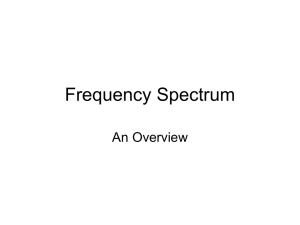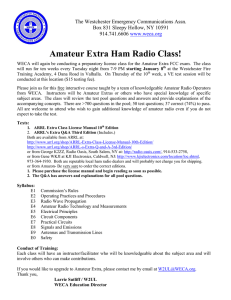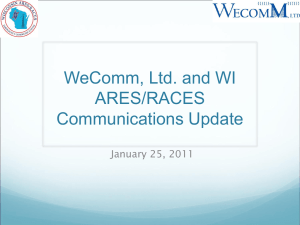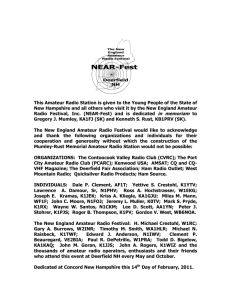David Pruett Portland, Oregon
advertisement
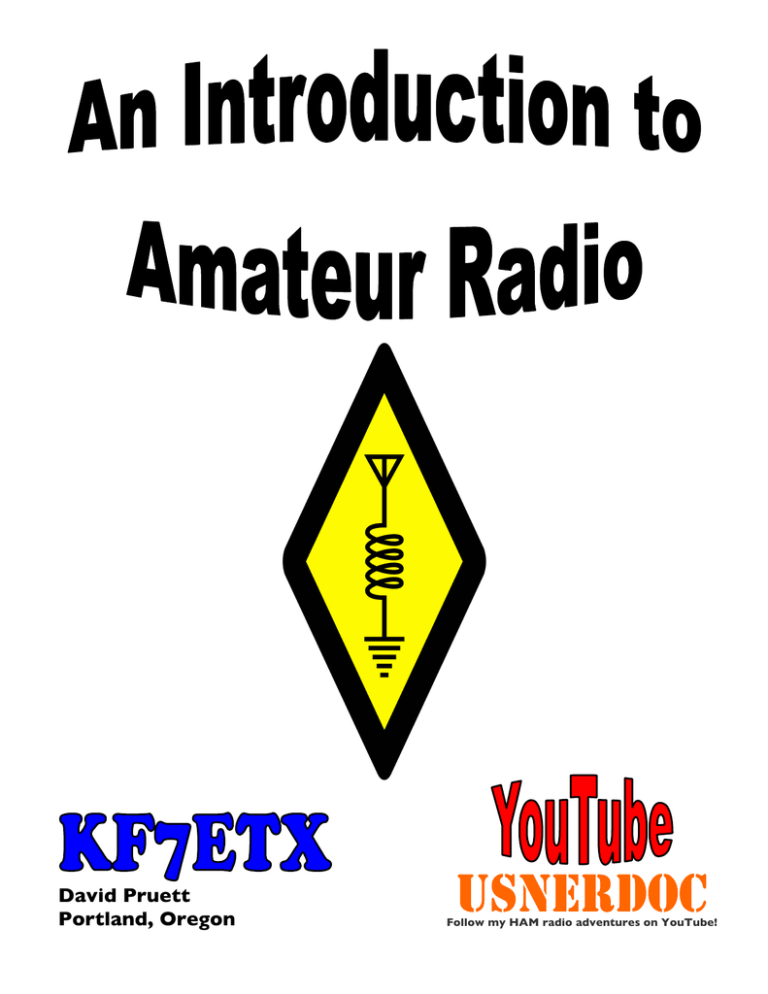
David Pruett Portland, Oregon Follow my HAM radio adventures on YouTube! Welcome to the exciting world of amateur radio! Where do I start? The first step is to study and get your operator’s license. On February 23, 2007, the Federal Communications Commission (FCC) eliminated Morse Code testing. The Morse Code requirement was a major stumbling block for many interested in amateur radio. While no longer required for licensing, Morse Code or CW remains an interesting and effective mode of communication by many amateur radio operators. New amateur radio operators typically enter the hobby by obtaining a Technician Class later advancing to the General Class or Extra Class. Volunteer Examiners (VEs) prepare and administer written examinations from published question pools publicly available. Helpful study guides, training courses and online resources are widely available. • Technician Class (Element 2) The privileges of a Technician Class operator license include operating an amateur station that may transmit on channels in any of 17 frequency bands above 50 MHz with up to 1,500 watts of power. Technician Class licensees also have privileges in four amateur service bands in the HF range. To pass the Technician Class examination, at least 26 questions from a 35 question written examination must be answered correctly. • General Class (Element 3) The General Class operator license authorizes privileges in all 27 amateur service bands. In addition to the above written examination, the requirement for a General Class operator license includes answering correctly at least 26 questions on a 35 question written examination. • Extra Class (Element 4) Operating privileges of an Extra Class operator license include additional spectrum in the HF bands. In addition to the two above written examinations, the requirement for an Amateur Extra Class operator license includes correctly answering at least 37 questions on a 50 question written examination. Always check that you are studying the most current question pool for each element. Practice Tests & Question Pool Resources QRZ Practice Test Center QRZ Practice Test Center (large print) http://www.qrz.com/xtest2.html http://www.qrz.com/xtestxl.html eHAM Practice Exams http://www.eham.net/exams/ HamExam Practice Exams & Flash Cards http://hamexam.org/ ARRL - Test Question Pools http://www.arrl.org/question-pools ARRL - Find a Local License Exam http://www.arrl.org/find-an-amateur-radio-license-exam-session The HamWhisperer http://www.hamwhisperer.com/ What can I do with a Ham License? • • • • • • • • • • • • • • • • • • • Doorway to the world! Talk to people in foreign countries . . . DX'ing is a favorite activity of many hams. Talk to people both local & distant while driving to work or someone on those sleepless late nights! Public assistance by providing communications during emergencies, natural disasters, parades, bike races, marathons and other public events Help other people become hams . . . also called "Elmering" Hook your computer to your radio and communicate "computer-to-computer" Collect QSL cards. Collect cards from other hams, from all over the world Participate in radio contests or ARRL Field Day events Provide radio communication services to your local Civil Defense organization o ARES (Amateur Radio Emergency Service) o RACES (Radio Amateur Civil Emergency Service) o FEMA (Federal Emergency Management Agency) Aid members of the U.S. military by joining the Army, Air Force or Navy/Marine MARS (Military Affiliate Radio System) Participate in “Fox Hunts” or transmitter hunt games Receive weather satellites pictures Operate low power from remote locations o SOTA – Summits On The Air Build radios, antennas, direction-finding equipment Learn some electronics & radio theory Talk to astronauts in space! Use the moon to bounce signals to talk with people on Earth Experiment with Amateur TV (ATV), Slow-Scan TV (SSTV), or send still-frame pictures by facsimile Connect your ham radio to the public telephone system & call friends toll free . . . “auto-patching” Communicate through orbiting satellites. Some Basic HAM Terminology ELMER DX CW VHF UHF HF 73 CQ QSO QSL QTH QRP Experienced HAM who teaches and nurtures the neophyte ham radio operator Hobby of tuning in and identifying distant radio stations Continuous Wave (morse code) Very High Frequency Ultra High Frequency High Frequency Best Regards Invitation for any operators listening on that frequency to respond Contact Acknowledge receipt Station Location Low Power The Amateur Radio Bands http://www.arrl.org/files/file/Hambands_color.pdf My First Station A great place to start as a new HAM is with a 2 meter / 70 centimeter dual band hand held radio. This will get you active on the local repeaters and nets, as well as, the amateur satellites and the International Space Station. Additionally, 2m / 70cm are the bands used by local emergency radio services such as ARES, RACES and CERT Teams. These radios are small, compact and very portable. They used with a “rubber duck” antenna, a magnet mount antenna on your car or portable antenna with a coax feed line. A handheld 5-watt handheld radio can be found used at very reasonable prices on eBay or the online QRZ Swap Meet. http://forums.qrz.com/forumdisplay.php?f=3 Ultimately you will be tempted to get a base station, upgrade your license and start making long distance contacts. A great resource for setting up your first station can be found at Ham Universe: http://www.hamuniverse.com/setuphamstation.html Station Identification Whenever you transmit on an amateur radio, you are required to identify your transmissions by giving your amateur callsign. Below are some helpful tips: • While common practice, you are NOT required to identify at the beginning of your transmission • You are required to identify with your callsign at least every 10 minutes • When you end your contact you are required to identify with your callsign • While not required, it is common practice for each station to identify themselves and the station(s) they are in contact (exception: international third party traffic) Time Coordinated Universal Time (UTC) is the time standard used by amateur radio operators to avoid confusion related to time zones and daylight savings time. UTC uses 24-hour (military) time notation and is based on the local standard time on the 0° longitude meridian which runs through Greenwich, England. For example, midnight in Greenwich corresponds to 00:00 UTC and noon corresponds to 12:00 UTC. For Mac and iPhone users there are some useful applications to consider: • For the iPhone take a look at the HamClock App (99¢) • For a Mac computer consider UTC Clock by Northern Software http://www.northernsoftworks.com/utcclock.html Antennas What is a Repeater? The purpose of a repeater is to allow its users a greater coverage area than that afforded by "simplex" or single channel operation. A repeater is generally located on the highest area in the locale or region to provide the best service to those who use it. Repeaters have separate input and output frequencies that are published in the ARRL Repeater Directory. Amateur Radio on YouTube Randy • K7AGE http://www.youtube.com/user/K7AGE Wil • AI4QT http://www.youtube.com/user/AI4QT John • W5CYF http://www.youtube.com/user/johnrob281 Steve • WGØAT Steve’s Blog http://www.youtube.com/user/goathiker http://n0tu.blogspot.com/ Andrew • K2FR http://www.youtube.com/watch?v=NLgiaydnN3o Mark • M0SVT http://www.youtube.com/user/markbeermonster David • KF7ETX http://www.youtube.com/user/USNERDOC Anderson Powerpole® Connectors RACES and ARES organizations, and most HAM radio operators, have now standardized on the Anderson Powerpole® for DC power connections. Start off in the right direction by adopting this power connection standard for your station. Anderson Powerpole® connectors offer the advantage of handling 15, 30 or 45 amps using the same connector (the contact must be matched to the current load). The connectors are genderless, meaning the supply and load connectors are the same. This reduces the number of parts required, however, just because Anderson Powerpole® connectors allow you to hook anything to anything, that does not mean that you can do so without thinking about the potential results! It is always necessary to know what you are connecting, what is a source and what is a load, and which sources should not be attached to other sources. http://www.andersonpower.com/ http://www.powerwerx.com/ ASSMEBLY OF AN ANDERSON POWERPOLE® CONNECTOR INTERIOR ANATOMY OF AN ANDERSON POWERPOLE® CONNECTOR USEFUL RESOURCES FOR THE HAM RADIO OPERATOR ORGANIZATIONS ARRL ARES RACES CERT Amateur Radio Relay League Amateur Radio Emergency Services Radio Amateur Civil Emergency Service Civilian Emergency Response Team http://www.arrl.org/ http://www.ares.org/ http://www.usraces.org/ http://www.citizencorps.gov/cert/ AMATEUR RADIO MANUFACTURES / EQUIPMENT Yaesu iCOM Kenwood Ten Tec http://www.yaesu.com/ http://www.icomamerica.com/en/ http://www.kenwoodusa.com/Communications/Amateur_Radio/ http://www.tentec.com/ Ham Radio Outlet Amateur Electronics Supply PowerWerkx Anderson Power Pole West Mountain Radio LDG Electronics MFJ Industries W4RT Electronics http://www.hamradio.com/ http://www.aesham.com/ http://www.powerwerx.com/ http://www.andersonpower.com/products/singlepole-connectors.html http://www.westmountainradio.com/ http://www.ldgelectronics.com/ http://www.mfjenterprises.com/ http://www.w4rt.com/ Nifty Mini-Manuals http://www.niftyaccessories.com/ BuddiPole S-9 Antennas http://www.buddipole.com/ http://www.s9antennas.com/ INTERESTING & USEFUL AMATEUR RADIO LINKS QRZ http://www.qrz.com/ Gordon West W5YI – VEC http://www.gordonwestradioschool.com/ http://www.w5yi-vec.org/ ARRL Question Pools Study Guides http://www.arrl.org/question-pools http://www.hamradioinstructor.com/guides.html Ham Universe http://www.hamuniverse.com/setuphamstation.html FCC Part 97 http://www.arrl.org/files/file/Part97_SinglePage.pdf Summits On The Air http://www.sota.org.uk/ ISSfanclum.com http://www.issfanclub.com/ Great Grounding Primer Antenna Basics http://www.hamuniverse.com/groundingbypolyphaser.pdf http://www.hamuniverse.com/basicantennas.pdf iPhone & iPad Applications for the HAM Radio Operator HamClock Local and UTC time MaidenHead Get your LAT / LONG / GRID for contests & satellite communications GoSatWatch Satellite / International Space Station / Shuttle tracking EchoLink Access to ECHOLINK for validated Echolink users & licensed Amateurs PocketPacket APRS client for iPhone / iPad . . . receive, view & send packet data PacketPAD View packet transmissions on iPhone / iPad Open APRS APRS client for iPhone / iPad QRZ Look up HAM radio callsigns Clinometer Great for estimating angle above horizon for satellite communications The Amateur's Code The Radio Amateur is CONSIDERATE never knowingly operates in such a way as to lessen the pleasure of others LOYAL offers loyalty, encouragement and support to other amateurs, local clubs, and the American Radio Relay League, through which Amateur Radio in the United States is represented nationally and internationally PROGRESSIVE with knowledge abreast of science, a well-built and efficient station and operation above reproach FRIENDLY slow and patient operating when requested; friendly advice and counsel to the beginner; kindly assistance, cooperation and consideration for the interests of others. These are the hallmarks of the amateur spirit BALANCED radio is an avocation, never interfering with duties owed to family, job, school or community PATRIOTIC station and skill always ready for service to country and community Adopted by the ARRL from the original version of “The Amateur's Code” written by Paul M. Segal, W9EEA in 1928 While no single document will ever be absolutely complete, I do hope this general primer is useful for those interested in getting involved with amateur radio operations. I am interested in correcting, updating and expanding this reference. Please email me with corrections, suggestions and updates! Welcome to a fascinating hobby with many areas to explore. See you on the airwaves! 73 – KF7ETX David Pruett Portland, Oregon usnerdoc@mac.com v1.0 – OCT 2010
